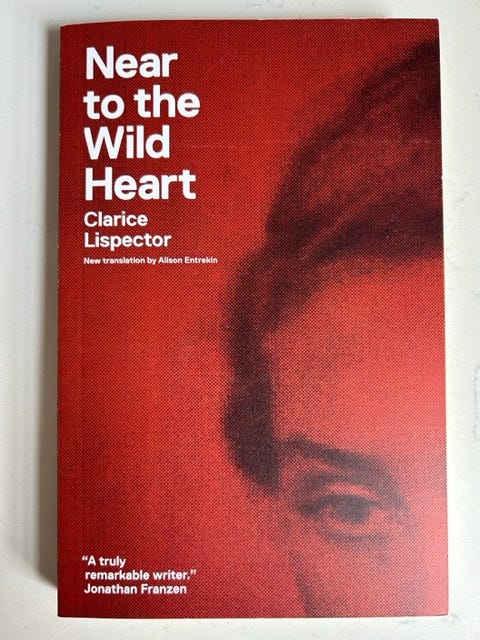'Near to the Wild Heart' by Clarice Lispector
'How can I punish myself enough, how to open myself to the world and to death?'—Review #212

I bought Clarice Lispector’s debut novel, ‘Near to the Wild Heart,’ for a silly reason. I had seen somewhere on the internet that four of her books could be combined into a portrait of the author’s face, like a literary Voltron, and I wanted to do that. I already had one of these editions, ‘The Passion According to G.H.,’ and now, with another, her face is half complete:
One day, I’ll get the other two books. Until then..
Here’s the cover:

‘Near to the Wild Heart’ follows Joana, a woman with a whirlwind interior life. Her story unfolds in a stream-of-consciousness style as it jumps back and forth in time from her childhood with her father, to adolescence after he dies and she’s living with an aunt, to boarding school and to adulthood where she’s in a loveless marriage with Otávio. There isn’t much plot, but we are in Joana’s mind as she grapples with doubt, loneliness, insecurities, emotions and fears about life, purpose, marriage, freedom, children and death. Her thoughts are all over the place, like any of ours would be when contemplating life’s big questions, and so are her actions. In one example, she startles her husband’s pregnant mistress by threatening to get pregnant by him herself. In another, as a teen she shoplifts a book because she feels like it, scandalizing her aunt, who’s like:

But Joana is not evil. The back cover of the book describes her as ‘feral’ and ‘amoral.’ Her behavior and thoughts could lead one to conclude she isn’t concerned about right and wrong, but I don’t think those words are completely accurate. She’s passionate and defiant, for sure, but her acts of defiance are masking insecurity and uncertainty instead of indifference. In her head, she’s just like the rest of us, going:
This edition of ‘Near to the Wild Heart’ includes an introduction by Benjamin Moser that describes a bit about Clarice Lispector’s life in 1940s Brazil, the significance of the book’s title (which is borrowed from James Joyce), and her process for writing the novel and crafting its ‘strange voice.’ It’s called ‘Hurricane Clarice,’ and I kept thinking about that title as Joana’s story unfolded in torrents of words, some some of them jarring, like the ‘naked chickens’ below. Lispector’s writing is a force of nature, powerful and flowing, but daunting. As I read, I kept hoping the storm would break, for things to settle down and be more straightforward. But it didn’t, and I struggled to push through, like:

Stream-of-consciousness novels like this are difficult for me. I find it hard to maintain my concentration without a plot to hold onto. In this case, I often would catch myself looking at my phone or thinking about what I wanted for lunch instead of focusing on Joana’s journey. While working on this newsletter, Donna asked what is the climax of the book. I drew a blank. The story does not wrap up neatly, perhaps showing that our struggle for self-understanding never really ends. In my own self-reflection, I’m thinking that I shouldn’t have read this in summertime, when I’m inclined toward books that are light and quick instead of raw and heavy. Still, I’m glad I read it, and I look forward to more of Lispector’s work. After all, I did enjoy ‘The Passion According to G.H.,’ and I’ve got a face to finish.
How it begins:
Her father’s typewriter went clack-clack … clack-clack-clack … The clock awoke in dustless tin-dlen. The silence dragged out zzzzzz. What did the wardrobe say? clothes-clothes-clothes. No, no. Amidst the clock, the typewriter and the silence there was an ear listening, large, pink and dead. The three sounds were connected by the daylight and the squeaking of the tree’s little leaves rubbing against one another radiant.
Leaning her forehead against the cold and shiny windowpane she gazed at the neighbor’s yard, at the big world of the hens-that-didn’t-know-they-were-going-to-die. And she could smell as if it were right beneath her nose the warm, hard-packed earth, so fragrant and dry, where she just knew, she just knew a worm or two was having a stretch before being eaten by the hen that the people were going to eat.
There was a great, still moment, with nothing inside it. She dilated her eyes, waited. Nothing came. Blank. But suddenly the day was wound up and everything spluttered to life again, the typewriter trotting, her father’s cigarette smoking, the silence, the little leaves, the naked chickens, the light, things coming to life again with the urgency of a kettle on the boil. The only thing missing was the tin-dlen of the clock that was ever so pretty. She closed her eyes, pretended to hear it and to the sound of the non-existent and rhythmic music rose up on tiptoes. She did three very light, winged dance steps.
My rating:

‘Near to the Wild Heart’ (Perto do coração selvagem) by Clarice Lispector was originally published in Brazil in 1943. The New Directions edition, translated from the Portuguese by Alison Entrekin, was published in 2012. 194 pages. $14.83 at Bookshop.org.
What’s next:
Before you go:
ICYMI: Review #211
Read this: Did you love season 2 of ‘The Bear’ as much as Donna and I did? Did you happen to glimpse all the cookbooks featured on the show? I love trying to figure out what books are on the shelves in the backgrounds of TV shows and movies, so I was excited to find that the newsletter Stained Page News made a comprehensive list of all the cookbooks in ‘The Bear.’ Check it out!
Read this, too: A newsletter that I recently subscribed to that I’m enjoying is ‘Art Dogs’ by Bailey Richardson, which is about famous artists and their dogs (and, occasionally, other animals). This issue features Toni Morrison’s cat, Zora, and is a fascinating look at the life of the famous author, as well as the cat’s namesake (and one of my favorite writers), Zora Neale Hurston.
If you enjoyed this review:
Thanks for reading, and thanks especially to Donna for editing this newsletter!
Until next time,

MPV










Reading Clarice is mandatory in most of Brazilians schools. So I am lucky to have read a lot of her work. My absolute favorite is "Apple in The Dark". Over here we call her "the mistery", because it was (and still is) so hard to truly understand all the depth in her writing. Benjamin Moser wrote her biography and it is a masterpiece. If you are into more of Brazilian literature I would recommend "Dom Casmurro", by Machado de Assis, It is very well written and also funny.
"and I’ve got a face to finish." 😂😂